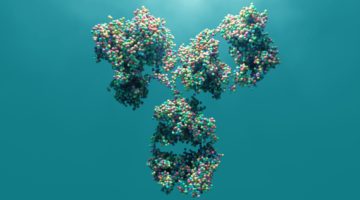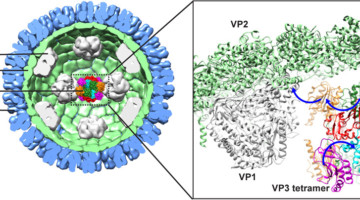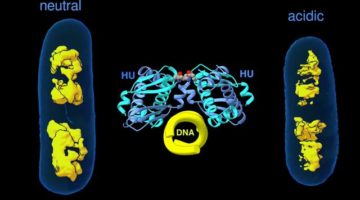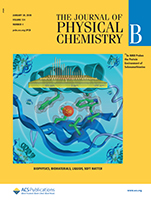Scientists discovered an ancient form of rubisco, the most abundant enzyme on Earth and critical to life as we know it. Found in previously unknown environmental microbes, the newly identified rubisco provides insight into the evolution of the photosynthetic organisms that underlie the planet’s food chains. Read more »
Providing New Technologies for Vaccine Development
Antigens can sometimes be attached to a protein scaffold to mimic the shape of a virus and elicit a stronger immune response. Scientists developed a method to design such proteins, and ALS data helped to visualize the atomic structure and determine the dynamics of the designed scaffolds. Read more »
Missing Lysine Link Could Improve Plant-Based Nutrition
To engineer crops with higher levels of the important amino acid, lysine, researchers solved the structure of an enzyme that helps break down lysine in plants. A fuller understanding of the factors affecting lysine levels should aid in the successful development of stable high-lysine crops to combat malnutrition globally. Read more »
How Proteins Remodel DNA in Bacteria under Stress
Multiscale, multimodal visualization techniques at the ALS enabled researchers to clarify how proteins remodel bacterial DNA in response to stressful environments. The discovery could lead to new strategies for controlling microbial behavior and, eventually, new ways to fight bacterial infections. Read more »![]()
![]()
Rotavirus VP3 Is a Multifunctional Capping Machine
Rotavirus, a major cause of infantile gastroenteritis, is responsible for the deaths of about 200,000 children per year. Although vaccines are available, the virus still circulates, and a fuller understanding of the viral structures is needed. Here, scientists investigate the structure and function of the last unsolved rotavirus structural protein. Read more »
Study Gains New Insight Into Bacterial DNA Packing
When bacteria are put in different environments, their genes start to adapt remarkably quickly because the proteins making up their chromosomes can pack and unpack rapidly. Researchers have now imaged this process at the molecular level, a discovery that could eventually enable scientists to develop strategies to control microbial behavior. Read more »
Staff at Berkeley Lab’s X-Ray Facility Mobilize to Support COVID-19-Related Research
X-rays allow researchers to map out the 3D structure of proteins relevant to diseases at the scale of molecules and atoms, and the ALS has been recalled to action to support research related to COVID-19, the coronavirus disease that has already infected about 2 million people around the world. Read more »
77Se NMR Probes the Protein Environment of Selenomethionine
Sulfur is critical for protein structure and function but lacks a sensitive isotope for nuclear magnetic resonance (NMR) experiments. This can be circumvented by substituting sulfur with selenium, which has an NMR-compatible isotope (77Se). To enable interpretation of the NMR data, the structures of five of protein variants were solved by x-ray crystallography to a resolution of 1.2 Å. Read more »
How Light-Harvesting Bacteria Toggle Off and On
Researchers clarified the atomic-level mechanism that enables bacteria to switch light harvesting off and on in response to potentially damaging overexposure to light. The results could have long-range implications for artificial photosynthesis and optogenetics—the use of light to selectively activate biological processes. Read more »![]()
![]()
X-Ray Studies Key in Study Relating to Immune System-Signaling Protein
A grouping of amino acids—part of an important signaling protein, STING—plays an important role in activating the immune system. A study conducted through the Collaborative Crystallography program at the ALS confirmed how this part of the STING protein helps to bind a protein-modifying enzyme associated with autoimmune diseases and some cancers. Read more »
- « Previous Page
- 1
- …
- 4
- 5
- 6
- 7
- 8
- Next Page »









